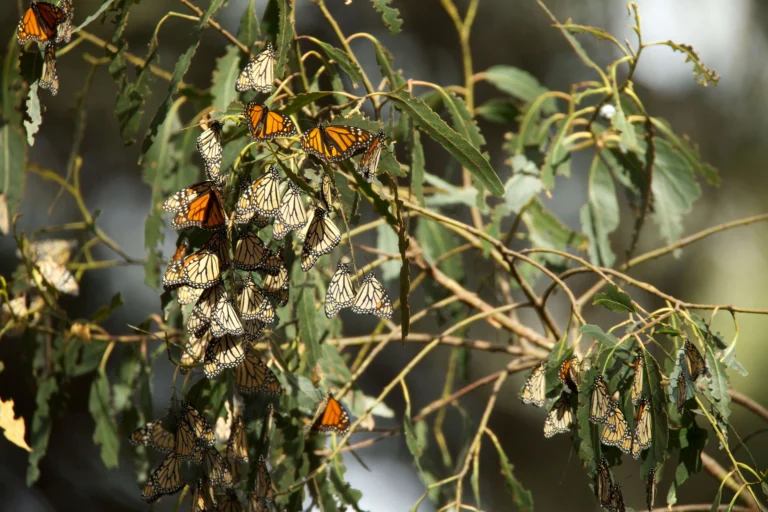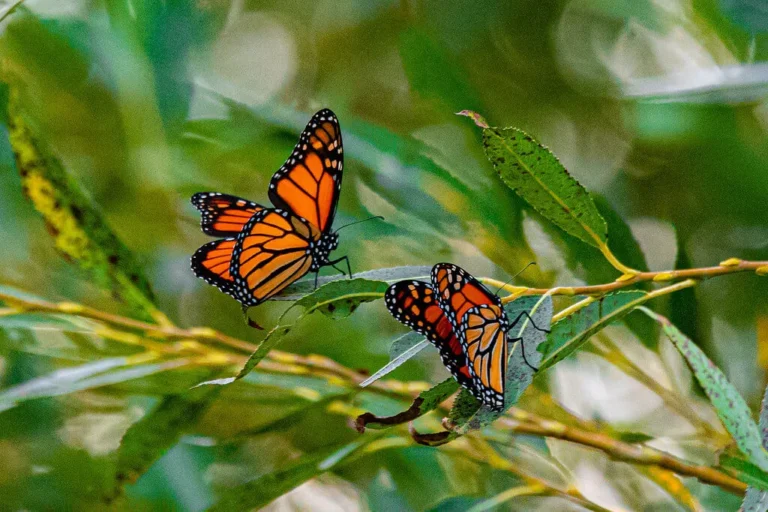Your Ultimate Guide to Monarch Butterfly Eggs: From Laying to Hatching Journey
Quick Summary: Monarch butterfly eggs are tiny, pinhead-sized eggs laid by female monarchs, mainly on milkweed plants. The eggs are pearl-white and change color before hatching in 3-5 days. After laying hundreds of eggs in her short life span, a complex life cycle begins, transforming from an egg to a caterpillar, then a chrysalis, and finally a butterfly in about a month. This fascinating process, rich with natural defenses and survival strategies, showcases the vibrant life and roles these creatures play in our ecosystem.
Table of Contents
Comprehensive Introduction
Monarch butterflies are truly a wonder of nature. They play a vital role in our ecosystem, helping in the pollination of a variety of plants. These fascinating creatures have a life cycle that is not only vibrant but also quite educational.
One of the most interesting parts of their life cycle is the egg stage. By taking a closer look at monarch butterfly eggs, we can learn a lot about these delicate creatures right from the beginning of their life journey.
Importance of Monarch Butterflies in the Ecosystem
Monarch butterflies are more than just beautiful creatures fluttering in the garden. They are hard-working pollinators, which means they help plants to reproduce.
When a monarch butterfly visits a flower to sip nectar, it accidentally picks up pollen on its body, transferring it to other flowers and helping them to produce seeds.
This process is essential for the survival of many plant species, which, in turn, provide food and habitat for a host of other organisms.
Hence, the presence of monarch butterflies significantly contributes to maintaining a balanced and thriving ecosystem.
Brief Overview of Their Life Cycle
The life cycle of a monarch butterfly is an enchanting journey that spans four stages: the egg, the larva (caterpillar), the pupa (chrysalis), and the adult butterfly.
This journey is nothing short of a marvel, as within a few weeks, a tiny egg transforms into a vibrant butterfly, ready to start the cycle all over again.
It’s a continuous circle of life, bringing new generations of butterflies to our gardens and wild spaces.
Significance of Studying Monarch Butterfly Eggs
Studying monarch butterfly eggs offers a glimpse into the early life stage of these remarkable insects. The eggs hold the secrets to the butterflies’ initial growth and development.
Observing and understanding this phase can provide valuable insights into their survival strategies, and what makes them one of the most beloved insects across the globe.
It sets the stage for the incredible transformation that is about to unfold, making it a critical part of the monarch butterfly life cycle.
Monarch Butterfly Egg Anatomy
Learning about monarch butterfly eggs is like hearing a magical story. In this part, we’ll look at the small yet interesting details of these little wonders.
How Big Are They?
Monarch butterfly eggs are incredibly tiny, almost like a pinhead. Generally, they measure about 1 to 1.2 mm in height and about 0.9 mm in diameter. Even though they are so small, their detailed structure and design are a testament to nature’s perfection.
What Do They Look Like?
To truly grasp the beauty of monarch butterfly eggs, we need to take a closer look at their color and texture.
- Appearance: These eggs are oval and have a soft yellow color. As the hatching time comes closer, they might turn a bit darker. The eggs have pretty lines from top to bottom, making them nice to look at, especially through a magnifying glass.
- Color Changes: At first, the eggs are a light yellow or creamy color. But as the little caterpillar inside starts growing, the color can change to a deeper tone, showing the exciting changes going on inside.
Structure and Material
Getting familiar with the structure of the eggs can be quite fascinating.
- A Safe Shell: Photos of these eggs show a neat and detailed design, almost like a small piece of art. The outside layer, known as the chorion, keeps the tiny baby inside safe. This layer isn’t just for safety; it has small holes that let air in, helping the tiny future butterfly grow.
- A Detailed Pattern: More photos let us see the bumpy surface of the eggs. This pattern, with long lines and cross-ribs, creates tiny squares on the surface, making them pretty to look at. Besides looking good, this pattern makes the egg stronger, protecting the new life inside from any harm.
The Laying of Eggs
The journey of a monarch butterfly’s life begins with the careful laying of eggs, a process that combines both beauty and precision. Let’s explore this captivating process step by step.
Mating Habits of Monarch Butterflies
Before the laying of eggs takes place, monarch butterflies find a mate in a beautiful dance in the sky. The males woo the females with their vibrant colors and aerial displays. After mating, females set off on a journey to find the perfect spot to lay their eggs, ensuring the next generation gets a healthy start.
Selection of Egg-Laying Sites
Choosing the right place to lay eggs is a critical task for a monarch butterfly. Let’s understand how they go about this process:
Where do monarch butterflies lay their eggs?
Monarch butterflies have a special preference for laying their eggs on milkweed plants. This plant not only provides a safe home for the eggs but also serves as a vital food source for the caterpillars once they hatch.
What plant do monarch butterflies lay their eggs on?
As mentioned, milkweed is the favorite choice. These plants contain a type of toxin that, when consumed by the caterpillars, gives them a bitter taste, deterring predators from eating them.
Timing and Seasonality
The timing of egg-laying is a vital aspect of the monarch butterfly life cycle.
When do monarch butterflies lay their eggs?
Monarch butterflies generally lay their eggs during the spring and summer months. This timing ensures that the caterpillars have enough food to eat as the milkweed plants are in full bloom during these seasons.
The Incubation Period
The laying of the eggs marks the beginning of a silent yet vibrant journey that unfolds inside the tiny shells. The incubation period is a time of anticipation and growth. Let’s explore what happens during this quiet yet significant phase.
Duration
Monarch butterfly eggs have a relatively short incubation period. Typically, it takes about 4 to 5 days for the embryo inside the egg to develop into a tiny caterpillar ready to venture out into the world.
This swift development showcases the efficiency of nature in ensuring the continuity of the monarch butterfly life cycle.
Conditions Affecting Incubation
The success of the incubation period can be influenced by a variety of factors. The temperature and humidity levels in the environment play a crucial role.
Warm and humid conditions can sometimes speed up the development process, while cooler temperatures might slow it down a bit.
Predators and Threats During Incubation
Sadly, the incubation period is not without its challenges. The eggs are vulnerable to a range of predators including ants, spiders, and even some birds.
Apart from predators, there can be threats from parasitic insects that lay their eggs inside the monarch eggs, exploiting them for their growth.
Understanding these threats is essential to appreciate the tough start these little creatures have in life, highlighting their resilience and will to survive.
Hatching Process
Seeing a monarch butterfly egg hatch is a wonderful experience, filled with hope and new beginnings. In this part, we will guide you through the stages of growth inside the egg and the first moments of a monarch butterfly’s life.
Stages of Growth Inside the Egg
Inside a monarch butterfly egg, a lot of fast growth and changes happen. Let’s look at the key steps leading to the hatching:
- Early Growth: In the first few days, the embryo inside the egg changes quickly. It begins to form the main parts of a caterpillar, including its head, body segments, and tiny legs.
- Just Before Hatching: As the embryo grows, it fills up more space in the egg. The outer part of the egg changes from creamy to see-through, letting us see the changes happening inside.
How Does the Egg Hatch?
The way a monarch butterfly egg hatches is a beautiful example of how clever nature can be. When it’s time, the little caterpillar inside uses a special “egg tooth” to break the shell open. This part falls off soon after it comes out. Now, the caterpillar is ready to start its life in the big world.
What Happens Right After Hatching?
Let’s think about the first few moments right after the egg hatches:
- Laying the Eggs: It’s interesting that a monarch butterfly never sees this part of its life. After laying the eggs, the butterfly flies away, leaving the new generation to grow up with the help of the surrounding environment.
- First Steps Outside the Egg: Once out of the egg, the baby caterpillar is quick to start its new life. It eats the nutritious eggshell first and then begins to eat the nearby milkweed leaves. This is the beginning of a time of fast growth for the young caterpillar.
Survival Tactics
Living as a tiny creature isn’t easy, but monarch butterfly eggs know how to survive. They use smart ways to stay safe and grow up in their world. Let’s find out how they manage to do this.
Hiding in Plain Sight
Monarch butterfly eggs are great at hiding from danger. Their light, creamy color looks a lot like the milkweed leaves they are found on, helping them stay hidden from enemies. This trick helps them stay safe from harm.
Staying Safe from Predators
Life is not easy for these tiny eggs. They face dangers from predators like ants, spiders, and birds. Let’s see how they stay safe:
- Safety with Milkweed: Choosing to lay eggs on milkweed plants is a clever move. These plants have a poison that keeps many enemies away. This gives the eggs, and later the caterpillars, a safe shield.
- Hidden on Leaves: You’ll often find these eggs alone or in tiny groups on the bottom of leaves. This smart plan helps keep them hidden from predators, reducing the chance of being found and eaten.
Why are Milkweed Plants Important?
Monarch butterflies and milkweed plants help each other in special ways. The plants offer a safe and helpful place for the eggs to grow. Here’s why these plants are so important:
- Food Source: After coming out of the egg, the young caterpillars munch on the milkweed leaves non-stop. This food gives them the nutrients they need to grow and change.
- Safety: As we mentioned before, the poison in milkweed plants keeps many enemies away. This helps protect the small caterpillars when they are most at risk.
- Home Sweet Home: Milkweed plants offer a cozy and safe home for monarch butterflies to lay their eggs. This ensures the eggs can grow up safely, helping continue the life cycle of their kind.
Monarch Butterfly Eggs vs. Aphids
At first glance, monarch butterfly eggs and aphids might seem like two unrelated entities in the garden. But observing closely reveals an interesting dynamic between them.
This section aims to highlight the distinguishing features and the interactions that might occur between these two.
Identifying Monarch Butterfly Eggs and Aphids
To the untrained eye, monarch butterfly eggs and aphids can sometimes look quite similar, especially given their small size. Here’s how you can differentiate between the two:
Monarch Butterfly Eggs:
As we know, they are tiny, oval, and have a creamy hue with a structured, textured surface, usually found on the underside of milkweed leaves.
Aphids:
On the other hand, aphids are small insects, usually green or black, with a more rounded body. They can be found clustered on leaves, stems, and sometimes even on flowers, feasting on the plant’s sap.
Interactions Between Monarch Butterfly Eggs and Aphids
Monarch butterfly eggs and aphids often share the same habitat, especially on milkweed plants. This coexistence can sometimes lead to interactions between the two:
- Competition for Resources: Since both rely on the same host plant for sustenance, there might be competition for resources. However, monarch caterpillars primarily feed on the leaves, while aphids extract sap from stems and leaves, minimizing direct competition.
- Predator Attraction: Aphids can sometimes attract predators, which might inadvertently pose a threat to monarch butterfly eggs as well, increasing the risk of predation.
Strategies for Protecting Monarch Butterfly Eggs from Aphids
Given the potential threats posed by aphids, here are some strategies to protect monarch butterfly eggs:
- Regular Monitoring: Keep a close eye on the plants where eggs are laid to notice any aphid infestation early on.
- Natural Predators: Encouraging the presence of natural predators of aphids, like ladybugs, in your garden can help keep the aphid population in check, indirectly safeguarding the monarch eggs.
- Gentle Removal: In case of a significant aphid infestation, gently removing them from the vicinity of the eggs can help protect future butterflies.
Fun Facts
Did you know that the world of monarch butterflies is full of fascinating details that are sure to amaze you? Here, we’ve gathered some interesting tidbits that will make you appreciate these beautiful creatures even more.
- Egg-Laying Marathon: A female monarch butterfly can lay hundreds of eggs in her lifetime. Quite a feat, isn’t it?
- Tiny Marvels: Monarch butterfly eggs are incredibly small, about the size of a pinhead. Despite their tiny size, they harbor a new life ready to embark on a phenomenal journey!
- Rapid Transformation: The journey from egg to adult butterfly takes about a month. In this short span, they transform from tiny eggs to voracious caterpillars, then into tranquil chrysalises before emerging as beautiful butterflies.
- Color Shift: As the egg nears the time to hatch, it changes color, giving a hint of the vibrant life that is about to emerge.
- Milkweed Buffet: Once hatched, the caterpillars enjoy a feast on milkweed leaves, growing rapidly before they transition to the next stage of their life cycle.
- Vital Role: Monarch butterflies play a vital role in the ecosystem. Not only are they pollinators, but they also serve as a food source for various predators, thereby maintaining a balance in the food chain.
Frequent Asked Questions
In this section, we’ll address some of the most common questions people have about monarch butterfly eggs.
Who lays monarch butterfly eggs?
Female monarch butterflies are responsible for laying eggs. After mating with a male monarch butterfly, the female searches for suitable plants (preferably milkweed) to lay her eggs, thus beginning the incredible life cycle of a new monarch butterfly.
How many eggs can a monarch butterfly lay?
A female monarch butterfly can lay hundreds of eggs during her lifetime, which spans about 2-6 weeks. Typically, she lays one egg at a time on the underside of milkweed leaves, a process that ensures the safety and availability of food for the emerging caterpillars.
How long does it take for monarch eggs to hatch?
Monarch butterfly eggs hatch within a short span of 3 to 5 days after being laid. The precise time can vary based on environmental conditions like temperature and humidity levels.
How long does it take from monarch egg to butterfly?
From egg to adult butterfly, the entire process takes about 4 to 5 weeks. This time includes the egg stage (3-5 days), the larval or caterpillar stage (10-14 days), the pupal or chrysalis stage (10-14 days), and finally emerging as an adult butterfly ready to continue the cycle.
Can you tell the gender of a monarch butterfly from its egg?
No, it is not possible to determine the gender of a monarch butterfly from its egg. The gender can usually be identified during the later stages of its development, primarily when it becomes an adult butterfly.
Male monarch butterflies have two black spots on their hindwings, which females lack. If you want to read a detailed comparison of Male Monarch Butterflies vs. females, Check out our guide.
Conclusion
Monarch butterflies are indeed one of nature’s most marvelous creations, and their journey begins from the moment they are laid as tiny, cream-colored eggs.
Through this blog post, we took a delightful stroll through various stages and aspects of the life of a monarch butterfly egg, shedding light on its anatomy, the laying process, and the strategies it employs to survive in the wild.
Recap of the Significance of Monarch Butterfly Eggs
As we’ve seen, the life of a monarch butterfly egg is a tale of resilience and beauty. These tiny eggs hold the future generation of butterflies, playing a crucial role in sustaining the ecosystem.
Understanding their anatomy, the laying process and survival strategies gives us a glimpse into the complex yet fascinating world of butterflies.



